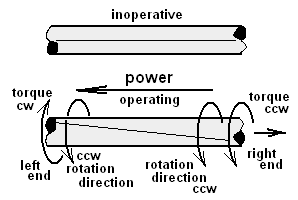| THERMO Spoken Here! ~ J. Pohl © | TOC NEXT ~ 181 |
3.26 Shaft Work

That work passes through shafts of machines is obvious. Yet a thermodynamic discussion is worthwhile. Consider a machine that has a power shaft but which is off, inoperative.
While the shaft is inoperative (not rotating) press a sharp-edged bar of steel cross-ways against the shaft and pull it from one end to the other, thereby leaving a scribed line the length of the shaft (shown as "inoperative"). Later, when the machine is running with a load, we position a variable frequency flashing light called a strobe light beside the shaft and adjust it to flash each precise instant the scratched line can be seen from beside the shaft.
The energy equation for the inoperative shaft is:

The rate of change of energy of the shaft is zero and so also are its "works" and "heats." Also all works are zero since the shaft is not rotating
Once its "event" commences, as the shaft begins to rotate, its rotational kinetic energy will increase. With expensive equipment the scar on the shaft can be seen to be twisted (ever so slightly) as power passes through it. This is shown in an exaggerated way in the sketch detail: "operating."
Work enters the shaft at the right end. The torque is clockwise there, so also is the direction of rotation. At the left end, by the observed twist of the shaft, the torque is seen to be counter-clockwise while the shaft rotates clockwise. Thus work enters at the right end exits at the left. The energy equation for this starting or transient change (friction assumed zero) is:

To speak of steady operation, let us first add a term to represent friction of bearings and gears of the shaft. System friction identifies closely with work; it is like a positive energy rate "TO" the system. An equation for transient operation is written below. Notice that the effect of friction is a constant increase of system energy. Gotta go!

Further comments on the above, later
As a case, consider the drive shaft of a truck stuck in mud, the wheels might have traction, slip, then have traction again in a repeated way. Loads on the shaft with such behavior are likely to increase the internal energy and thereby the temperature of the shaft to the point the shaft breaks (shears).
Shaft Work

That work passes through shafts of machines is obvious. Yet a thermodynamic discussion is worthwhile. Consider a machine that has a power shaft but which is off, inoperative (top view). While the shaft is inoperative (not rotating) press a sharp-edged bar of steel against the shaft and draw it from one end to the other thereby leaving a scribed line the length of the shaft (shown as "inoperative").
Premise presently unwritted!